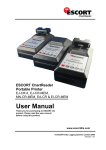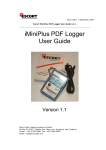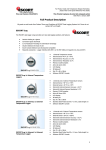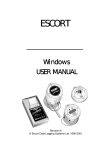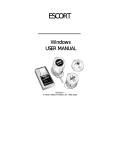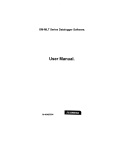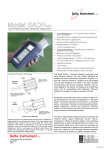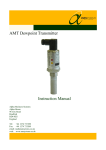Download Escort iLog User guide
Transcript
iLog User Guide Contents Contents ....................................................................................................................................2 Safety Instructions ....................................................................................................................3 Safety Instructions ....................................................................................................................4 Logger features .........................................................................................................................5 iLog Display...............................................................................................................................5 Connecting your iLog to your PC .............................................................................................6 Installing and using a USB to serial port cable........................................................................6 Installing ESCORT Console ......................................................................................................7 Programming your iLog logger ................................................................................................7 Description & Passwords ..............................................................................................10 Connecting a sensor .....................................................................................................11 Configuring logger sensors ...........................................................................................11 Setting a date and time .................................................................................................17 Setting start conditions..................................................................................................18 Logger summary...........................................................................................................19 Program window ...........................................................................................................20 Bookmarking.................................................................................................................22 Downloading your iLog logger ...............................................................................................23 Commencing Download ................................................................................................23 Analysing your downloaded information ........................................................................28 Viewing downloaded information...................................................................................29 List of readings .............................................................................................................29 Readings and Summary................................................................................................30 2D Line graph ...............................................................................................................30 Step Graph ...................................................................................................................31 Cleaning an iLog’s humidity sensor.......................................................................................35 Specifications..........................................................................................................................36 Warranty information ..............................................................................................................37 Contact details ........................................................................................................................38 2 iLog User Guide Safety Instructions In no circumstance should heavy force be applied to your iLog logger. Applying heavy force to any part of your iLog could result in logger malfunction and/or injury. Your iLog logger should only be operated within the parameters specified in the technical data discussed within this user manual. A failure to follow these instructions could result in you iLog logger malfunctioning and cause permanent damage to the unit. Certain models of iLog loggers are vulnerable to damage when contact with water takes place. Please check your iLog loggers IP rating before placing your iLog logger in such conditions. Your iLog logger is not to be subjected to a naked flame. Exposures to such conditions may result in damage to your iLog logger, and result in an explosion of the battery. Never operate your iLog logger with a low battery. We recommend that you replace the battery as soon as the battery low symbol is indicated on your iLog logger’s display. For iLog loggers which operate external sensors, we recommend that the sensor be unplugged by holding the gold connector, not removed via the sensor cable. Do not attempt to repair or modify any part of this logger. Such actions will result in a loss of warranty. All repairs are to be made by an official ESCORT Data logging Systems service centre. For iLog loggers which operate external sensors, it is important to keep the sensor tip clean to ensure that the data collected is accurate. 3 iLog User Guide Safety Instructions In order to keep your iLog loggers recordings accurate, we recommend that you perform annual calibration of this device. If an iLog Humidity loggers humidity sensor comes into direct contact with moisture it will not perform accurately. We recommend that that you clean your iLog’s humidity sensor on a regular basis (see instructions located within this manual). Once your logger’s case has been opened and the warranty seal is broken your iLog logger is no longer covered by warranty. This includes the replacement of your logger’s battery. Only subject your iLog logger external sensor(s) to temperatures below -40 ºC. The logger itself is not designed to operate at temperatures below this point. Battery life depends greatly on the quality of battery fitted, the temperature your iLog logger is operated at and the recording frequency your iLog logger is logging at. Do not use batteries other than those specified in our documentation. A failure to use the correct battery could result in poor performance and/or logger malfunction. 4 iLog User Guide Logger features Internal, Internal/External, Two External and Internal/humidity sensor options. Rear label specifying product code and serial number plus bar coded serial number according to EAN 128. Lug (loop on top) to fix logger on wall or other surface as required. Removable external temperature sensor options (depending on model), with external sensor connector(s) being located on either side of your logger's case for fast temperature response. Display showing last temperature measurement taken plus alarm status (High Alarm / Low Alarm), or status of the logger. Optional statistics (e.g. highest, lowest, and average) can be chosen during logger programming. Start the logger via magnet swipe or pre-program to start at a specific date and time. Logging interval as low as 1 second per reading and as high as one day (24 hours). User replaceable battery. To replace the battery, simply remove the three screws located on the rear of your logger’s case. Carefully pull the front half of the logger away from the back, being careful not to lose the rubber seal located inside the lid, and the three small seals, located on each screw. Replace the battery and seals in correct position. For humidity loggers, DO NOT touch the sensors. Seal your logger’s case with the three logger screws. Note: Stored readings cannot be lost by removing the battery. However if you are currently logging, or you need the real-time clock to keep time, it is important that you replace your old battery with a new battery immediately upon removal of the old battery. iLog Display 5 iLog User Guide Connecting your iLog to your PC You can connect your iLog logger directly to an ESCORT Logger Interface, which is attached to a serial port located on your PC. Remember the COM port that the logger was connected to and open your ESCORT Console software. To learn how to use our ESCORT Console Software, kindly refer to the help file attached to the software or section. Installing and using a USB to serial port cable Close any ESCORT software which may be currently running on your machine. Open the Device Manager (Click Start, go to Control Panel, choose System, in Hardware tab click on Device Manager) and look up which COM ports are already available Connect a USB to serial port adapter (available from ESCORT as JA-USB-SER or at your local electronics store) to a USB port on your computer Do not connect the logger interface to the USB cable yet Install the USB to serial port adapter Windows XP: Wait for operating system to recognize the new hardware (USB device). Windows 98 and 2000: Follow Installation Manual delivered with the adapter Simplified instructions for JA-USB-SER: Restart you computer Plug in the USB-Serial cable into the USB port and run the Add New Hardware Wizard (Click Start, go to Control Panel, choose Add Hardware) to assist you in setting up the new device Insert the USB-Serial cable software driver into the CD-ROM drive and locate the driver on the CD-ROM drive D:\un8be-a\pc driver (D: represents CD-ROM) Follow the instructions provided within the provided driver disc Complete installation using the Add Hardware Wizard See the Device Manager (screenshot on right) to check which number was assigned to the new COM port USB Serial Port Connect your iLog logger and interface to your USB serial port adapter Note: It is not possible to install the USB to serial port cable drivers on thin client work stations. A thin client is a term used to describe a network computer that is designed to interface with a client’s server directly. A thin client does not have a hard disk drive, whereas a fat client includes a disk drive. Example of a thin client work station 6 iLog User Guide Installing ESCORT Console Download ESCORT Console software from our website (www.escortdls.com) or insert your software CD JA-SWP-WIN into your CD Rom drive. Follow the on-screen instructions taking you through the installation process. Read the warnings and information carefully. Open ESCORT Console. Choose the COM port that your iLog is connected to. This dialog appears automatically when you first install ESCORT Console. If you have already used Console before, go to the Edit menu and choose the command Options. In the Communication tab you can select the correct COM port. If you are using a USB to serial port converter you may have to look up the correct COM port number in your Device Manager. Select the iLog tick box as one of the ESCORT products you want to use. This dialog appears automatically when you first install ESCORT Console. If you have already used Console before, go to the Edit menu and choose the command Options. In the Products tab you can select the ESCORT products you wish to use and put them into the sequence in which ESCORT Console will search for them Read tips of the day. Turn off this feature by ticking the box on the bottom if you do not wish to see those tips in the future. The help file is the ESCORT user manual. Go to the Help menu and choose the command Help Topics. If you use ESCORT products for the first time, have a look at the “Quick Start Guide” in the Common Topics. 7 iLog User Guide Programming your iLog logger Open ESCORT Console. Connect your iLog to an ESCORT interface and ensure the correct COM port is selected in Console. From the Action menu, select the ‘Program and Configure’ command. Follow the on-screen instructions (see below). Once you have opened the ‘Program and Configure’ wizard a welcome screen will appear (see figure 1.4). If you do not wish to see this message when downloading future loggers, select the ‘Do not remind me of this again’ tick box, located at the bottom left of the screen, followed by the ‘Next’ button (see figure 1.4). Select this tick box if you do not wish to see the welcome screen before programming your logger(s) Figure 1.4 – ‘Program and Configure – Welcome’ window 8 iLog User Guide The ‘Program and Configure’ wizard will display the following window (see figure 1.5 below). If your iLog logger cannot be programmed the logger tick box (located below the description heading) will not be checked and you will not be able to proceed. If your logger is passwordprotected, you will be prompted for the password upon selecting the tick box. To proceed to the next stage of the ‘Program and Configure’ wizard select the next button located at the bottom of the wizard window. Logger tick box Figure 1.5 – Program and Configure Search Window 9 iLog User Guide Description & Passwords The ‘Details’ window allows for the assignment of a unique logger description for easy logger identification and the ability to assign a password to your iLog logger (see figure 1.6 below). To assign a password click the ‘Change Password’ button located at the bottom right of the ‘Program and Configure Details’ window (see figure 1.6 below). The ‘Password Settings’ window will appear (see figure 1.7). Here you are given two options, the ‘Protect program settings’ option, which provides for the protection of the programming settings you have issued for you logger. The second option is the ‘Protect retrieval of readings’ option, which disallows individuals from viewing information downloaded from your logger without a password. Once you have selected the password protect options you require and have entered and confirmed your password select the ‘OK’ button. Once you have entered a description and password (if required) select the ‘Next’ button. Select to assign Password to your iLog Figure 1.6 – Program and Configure Details Window 10 iLog User Guide Password options – Tick to select Figure 1.7 – Password Settings Window Connecting a sensor iLog loggers have internal and external sensor options. The models of iLog that have external sensor options are EI-1E-D-32-L, EI-1E-DC-32-L and EI-2E-32-L. Users are able to connect external sensors to their iLog by inserting the sensor connector into the sensor socket located on the left and/or the right side(s) of the logger (see figure 1.8). iLog sensor connecting socket. Insert sensor connector to add sensor to your iLog logger Configuring logger sensors Following the ‘Details’ window is the ‘Sensors’ window, which allows for the selection and configuration of you iLog’s sensor(s). All of the sensors attached to your logger will be automatically selected, if you do not wish to use a particular sensor for any reason, simply deselect the tick box located to the left of the sensors icon (see figure 1.9 below). 11 iLog User Guide Select to Configure Sensor(s) Sensor options – Tick to select or deselect Figure 1.9 – Program and Configure Sensors Window If you wish to configure your logger’s sensor(s), simply highlight the appropriate sensor(s) and select the Configure Sensor(s) button located in the top left corner of the ‘Program and Configure’ window. To select multiple sensors, hold the control key (located on your computers keyboard) down and select the appropriate sensors. Once you have selected the ‘Configure Sensor(s) button, a new screen will appear that allows you to add and alter the different features relating to each of your loggers sensors. 12 iLog User Guide The first window to appear is the ‘Configure Sensors - Information’ window (see figure 1.10), which supplies specific information relating to you logger and allows for the addition of logger description for easy logger identification. Once you have entered a description and checked your sensor(s) information, click the ‘Next’ button. Description text box Enter text and select the ‘Next’ button Figure 1.10 – ‘Configure Sensors – Information’ window 13 iLog User Guide The second window displayed is the ‘Configure Sensors – Specification’ window (see figure 1.11). This window provides you with the ability to add and adjust your sensor(s) out of specification settings and the increment in which your ESCORT Console software will display changes in your logger readings. Change your sensor settings by applying the required temperatures to the text boxes or using the scrolling arrows located to the right Figure 1.11 – ‘Configure Sensors – Specification’ window 14 iLog User Guide The third window is the ‘Configure Sensors – alarm’ window (see figure1.12). You can select a series of different option relating to your sensor(s) alarm settings by selecting the corresponding tick box. If you wish to alter the number of out of specification readings or consecutive readings out of specification that a logger records before generating an alarm, simply select the appropriate tick box and enter the required number into the text box provided or use the scrolling arrows located to the right of the text box. Change your alarm settings by applying the required figures into the text boxes or using the scrolling arrows located to the right Figure 1.12 - ‘Configure Sensors – Alarm’ window 15 iLog User Guide The fourth window is the ‘Configure Sensors – Display’ window (see figure 1.13). This widow provides you with the ability to activate or restrict the information displayed on your loggers screen. To alter your logger display settings, first ensure that you have selected the ‘Show this sensor’s readings on display’ tick box. You also have the ability to select the unit of temperature you would prefer and the number of seconds that your logger will pause for before advancing to the next display setting. Once you have selected the combination of logger settings that wish to view, select the ‘Finish’ button. Select this tick box before attempting to select the text boxes below Change these settings by selecting the arrows located to the right Figure 1.13 - ‘Configure Sensors – Display’ window 16 iLog User Guide Setting a date and time Following the ‘Sensors’ window is the ‘Date/Time’ window (see figure 1.14), which allows for the selection and configuration of you iLog’s clock settings. You are given three options; the first allows you to simply keep your loggers current clock settings. The second option is the recommended option and updates your logger with you computers current clock settings. The final option allows you to manually enter a date and time for your logger. To manually change your clock settings, simply select the scrolling arrow keys. Alternatively, if you select the larger arrow to the left of the scrolling arrow keys, a calendar will appear, allowing you to simply select the date that you require. Select an appropriate radio button to alter your logger’s clock settings Select large arrow to view calendar Figure 1.14 – ‘Program and Configure - Date/Time’ window 17 option. iLog User Guide Setting start conditions Following the ‘Date/Time’ window is the ‘Start-up’ window (see figure 1.15), which allows for the selection and configuration of you iLog’s start-up settings. This window allows users to enter a logger’s trip duration from 0 to 60 days, define your loggers recording intervals (1 hour to 10 days), enter your logger start conditions (magnetic start, or programmed start), enter your logger finish date and time, select whether you require continuous background logging and provides the ability to enable the beeper within the logger. Enter your logger’s reading interval settings by selecting the scrolling arrows Enter trip duration by clicking on the drop down box Program your logger for continuous logging Enter your logger’s start settings by selecting the scrolling arrows Select tick box to enable the beeper within you logger Figure 1.15 – ‘Program and Configure – Startup’ window 18 Enter your logger’s finishing settings by selecting the scrolling arrows iLog User Guide Logger summary Following the ‘Startup’ window is the ‘Summary’ window (see figure 1.16), which provides a brief summary of you iLog’s startup settings. Once you have checked that your logger’s settings are correct, simply click the ‘Program’ button. Check the logger details and select the program button Figure 1.16 ‘Program and Configure – Summary’ window 19 iLog User Guide Program window The final window to be displayed is the ‘Program’ window (see figure 1.17), which is simply an indication that your updated logger settings are being uploaded into your iLog logger’s memory. Once your logger has been programmed the ‘Program and Configure’ wizard will allow you to program additional loggers with the same settings. To do this simply click the ‘Program and Configure addition devices with the same settings’ tick box located at the bottom left of the window and select the ‘Next’ button (which will appear after the tick box has been selected) (see figure 1.18). Figure 1.17 ‘Program and Configure – Program’ window 20 iLog User Guide Select this tick box to program additional loggers with the same settings and select the ‘Next’ button (which will appear once the tick box is selected) Figure 1.18 - ‘Program and Configure – Program’ window 21 iLog User Guide Bookmarking A bookmark is an identification method used to locate a place or time when an action has taken place. iLog users have the ability to ‘bookmark’ logger readings by swiping a magnet over the iLog’s label. Once your iLog is downloaded, your ESCORT Console software will highlight bookmarked readings using the colour green (see figure 1.19). A bookmarked reading as shown in an ESCORT Console readings report A bookmarked reading as shown in an ESCORT Console line graph Figure 1.19 Bookmarking in ESCORT Console 22 iLog User Guide Downloading your iLog logger Open ESCORT Console. Connect your iLog to your ESCORT interface and ensure the correct COM port is chosen in Console. In the Action menu, choose the ‘Download’ command. Follow the on-screen instructions (see below). Commencing Download The first window to be displayed in the ‘Download’ wizard is called the ‘search’ window, and displays a task bar which simulates that a logger search is taking place. Once a logger is located the following screen will appear (see figure 2.1). If your logger has been recording and has information saved within its memory a tick box will be checked to the left of the iLog icon. If the tick box is not checked this indicates that your logger has no recorded information within its memory, your logger is unable to be downloaded, or your logger is password protected. If your iLog logger is password protected please refer to the relevant password information located on page ten and eleven of this user manual. To proceed to the next stage of the ‘Download’ wizard, select the next button located at the bottom of the window. Logger tick box Download button Figure 2.1 – ‘Download – Search’ window 23 iLog User Guide Download Readings The second window to be displayed in the ‘Download’ wizard is called the ‘download’ window, and displays a task bar which simulates that a logger download is taking place (see figure 2.2). Once the wizard has successfully downloaded your logger the ‘Next’ button located at he button of the window will become available, simply select the ‘Next button to proceed. If a logger download is unsuccessful, the following window will appear (see figure 2.3). If this occurs, simply click the search button (see figure 2.3) or return to step one. Figure 2.2 – ‘Download – Download’ window 24 iLog User Guide Select the search button to reattempt logger download Figure 2.3 - ‘Download – Unsuccessful search’ window 25 iLog User Guide Logger summary and start conditions The fourth window to be displayed in the ‘Download’ wizard is called the ‘Finish’ window. This window allows for start conditions to be added to your logger once your loggers download is complete (see figure 2.4). To change your logger settings select the appropriate radio button located to left of the ‘Download’ window (below the heading ‘Logger options’). If the start setting requires specific date and/or time, simply use the scrolling arrows located to the right of the appropriate text box (see figure 1.4). Once you have assigned the appropriate start conditions to your logger select the ‘Rearm’ button. If you would prefer not to interrupt your loggers recording cycle please select the ‘Do not upload any new start conditions to the logger(s) radio button. Logger start condition Radio buttons. Select to activate appropriate start conditions Use the scrolling arrows to alter start conditions Select large arrow to view calendar Figure 2.4 - ‘Download – Finish’ window 26 iLog User Guide Rearming your iLog If you choose to rearm the logger, the final screen to be displayed within the ‘Download’ wizard is the ‘Rearm’ window (see figure 2.5). This window is helpful when you have more than one logger to download. To use this function select the ‘Download information for additional Loggers and/or ChartReaders tick box and select the next button. You will then repeat steps one through four. Select this tick box to download additional loggers Click the ‘Next’ button to proceed Figure 2.5 - ‘Download – Rearm’ window 27 iLog User Guide Analysing your downloaded information Once downloaded using ESCORT Console, the data saved within your iLog logger will be displayed as a readings summary. Within this summary you are able to view the following information; your logger’s serial number, hardware version, trip number, your loggers description (if assigned), battery status, the time zones with which your logger was programmed and downloaded, the time your logger started and finished logging, your loggers sampling interval, the number of readings recorded, the temperature range it recorded within, the alarm limits and the highest, lowest and average readings. Information relating to your downloaded iLog logger file Figure 3.1 Downloaded file Below the information relating to your loggers you will see each individual reading which was saved within your logger, the date and time the reading was recorded, bookmarked readings (if recorded) and if your logger has more than one sensor attached, you will see the readings displayed adjacent to each other. Reading number, date and time of iLog information downloaded Temperature readings for a two sensor iLog logger Figure 3.2 Downloaded readings 28 iLog User Guide Viewing downloaded information Your ESCORT Console software provides the ability to view your iLog logger data in several different formats. These formats are; Readings (list of readings and readings and summary), 2D graph (line and step) and summary (overview, statistics, analysis and out of specification). You are able to access the different views by selecting (double click to select) from the views menu located on the left of your Console window. The different views available in ESCORT Console software Figure 3.3 Different views List of readings The first option under the readings menu is the list of readings menu option. This option displays a list of your loggers reading in their entirety. If you have an iLog with two sensors, Console will display your logger’s readings side by side. Console displays reading number, elapsed time, date, time of reading and temperature/ humidity readings Figure 3.4 List of Readings 29 iLog User Guide Readings and Summary The second option under the readings menu is the readings and summary menu option. This is the default menu option and displays all the information mentioned in the analysing your downloaded information section on page 28. Figure 3.5 Readings and Summary 2D Line graph The first menu option under the 2D Graph menu is the line graph menu option. Here your logger data is displayed in an easy to view format, with each sensor displayed in different colours and if required your above/below specification limits and calibration limits are marked in different colours. To customise the way in which you view your graphs please refer to the help files supplied with your Console software. Figure 3.6 Line Graph 30 iLog User Guide Step Graph The second menu option under the 2D Graph menu is the step graph menu option. This format is similar to that of the line graph format except that changes in the readings are shown as a line as opposed to smooth lines. Figure 3.6 Step Graph Summary Overview The first menu option under the Summary menu is the Overview menu option. This menu option provides the basic information relating to your downloaded logger file, such as; your logger’s serial number, hardware (firmware) version, logger description, battery status, time zone information, start and finish times, sampling frequency, operating temperature and time out of specification. Figure 3.7 Summary Overview Statistics 31 iLog User Guide The second menu option under the Summary menu is the Statistics menu option. This menu option provides the basic statistics relating to your logger file, including; your loggers serial number, description and average, highest and lowest readings. Figure 3.8 Statistics Analysis The third menu option under the Summary menu is the Analysis menu option. This menu option is a combination of the summary overview and statistics menu options. Figure 3.9 Analysis Out of Specification 32 iLog User Guide The fourth menu option under the Summary menu is the Out of Specification menu option. This menu option simply displays those readings in your downloaded file which are above or below the alarm temperatures specified. Figure 3.10 Out of Specification Note: For detailed information regarding the operation of ESCORT Console please refer to the help guide provided within the software. You can access the help menu via the dropdown menu Help, or CONTROL H. Alternatively you can select the help symbol from the Console task bar located below the dropdown menu, and click on an item located on the screen that you require assistance with. Help menu option Help cursor Figure 3.11 Help options 33 iLog User Guide Changing your iLog’s battery You have the ability to change your iLog’s battery, but once opened your loggers IP rating becomes void and will not be covered under warranty. To replace your logger’s battery, please follow the following steps: 1. Purchase a SAFT 3.6V ½ AA, Lithium battery (can be purchased through your ESCORT distributor or local electronics store). 2. Remove the three screws located on the rear of your iLog logger. 3. Carefully separate the two halves of your iLog’s plastic case and ensure that you can locate the three small screw o-ring seals and larger o-ring case seal. Note: If you are changing the battery on an iLog humidity logger it is important not to make contact with the sensor. If you accidentally remove the humidity sensor and bung from the iLog case, you can reinsert the sensor using the guide hole in the PCB (Printed Circuit Board). 4. Move the battery located within the battery compartment so that the batteries polarity can be viewed. The polarity of the battery should be as follows + C -. 5. Remove the battery by pushing firmly on either end of the battery and pulling the battery towards you. 6. Insert the new battery by separating the battery springs, ensuring that the battery is fitted in the correct direction (polarity + C -). 7. Place the three small screw o-ring seals and larger o-ring case seal on their appropriate positions and replace the lid of your iLog case ensuring the lid of the case is the correct direction. 8. Finally, re-attach the three screws located on the back of the logger case so that a tight seal is formed between both case halves. iLog back view iLog side view 34 iLog internal view iLog User Guide Cleaning an iLog’s humidity sensor The iLog humidity sensor needs to be clean in order to operate at an optimum level. If your iLog’s humidity sensor comes into contact with a foreign object (e.g. fingers), it is vital that the sensor is cleaned with a cleaning solution. We recommend that a cleaning solution which is 50% isopropyl alcohol (IPA) and 50% water is used to clean the sensor. We also advise that you use a cotton bud or clean cloth to clear the sensor of foreign materials. iLog humidity internal view iLog humidity sensor 35 iLog humidity and temperature sensor iLog User Guide Specifications iLog Temperature Logger Temperature Range D range -40ºC to 70ºC (-40ºF to 158ºF) C range -20ºC to 100ºC (-4ºF to 212ºF) N range -100ºC to 40ºC (-148ºF to 104ºF) Specifications Internal, Internal/External, 2x External and Internal/Humidity Memory 32,000 readings Resolution 0.1ºC (0.2ºF) Accuracy +/- 0.3ºC LCD Software programmable LED’s Active and Alarm Data Recovery Via standard ESCORT PC interface and ESCORT Console software Size Diameter 76mm, height 36mm IP Rating Internal sensor IP67, others IP51 Warranty 2 years (excluding battery) Power 1x User replaceable SAFT 3.6 volt ½ AA battery Case Material Polycarbonate iLog Humidity Logger Humidity Range 0 – 100% RH Memory 32,000 readings Resolution 0.1% RH Accuracy +/- 3% 36 iLog User Guide Warranty information Warrant conditions are set out the ESCORT Data Logging Systems’ current Terms and Conditions as published on the date a claim is made. Below please find the wording as per version TCEDLSINT042. This is, however, not binding and the current Terms and Conditions will prevail over the details given here. Product Warranty period is 24 months (excluding batteries). Warranty does not cover: - Loss of use or consequential loss, - Calibration if the unit has been subject to environmental conditions outside the specified ones - Willful damage, mistreatment, misuse or abuse of the product, - Loss or damage caused by the ingress of moisture, unless ordered with immersion rating, - Batteries, - Circumstances where the unit has been modified from manufacturers specifications, - Exposure of the logger to temperatures outside the specified storage temperature, - Exposure of the logger to environmental conditions outside the specified ones In case of a warranty claim ESCORT Data Logging Systems Ltd. will repair the goods or supply an equivalent replacement. In some circumstances, where a specific return was authorized, ESCORT Data Logging Systems Ltd. may permit the use of its Federal Express account for returning goods. Such permission is valid ONLY for the authorized shipment. ESCORT Data Logging Systems Ltd. will not accept any freight charges for goods that have been returned without ESCORT Data Logging Systems Ltd’ s expressed permission. Customers and distributors may return product to us for accuracy testing, if they have doubts as to the product’s overall accuracy: - If the product is returned within the warranty period, a Traceability certification will be performed, and a certificate issued. - If the logger does not pass the certification, i.e. the logger is at fault, the logger will be replaced or repaired as per the warranty conditions and no charges (other than freight charges) will apply. The new logger will be issued with a Traceability certificate free of charge. - If the logger reads within the specifications, a Traceability certificate will be issued and you will be charged for this service. - If the product is returned outside the warranty period, a Traceability certificate will be issued and charged regardless of the outcome of the test. - ESCORT Data Logging Systems Ltd. will not pay for any performance tests undertaken by any outside organization without prior approval. Recycling of electronic devices Some parts in products from ESCORT Data Logging Systems consist of recyclable materials, but others should not be disposed of in household waste. To avoid pollution, we kindly ask you to adhere to national policies and regulations concerning waste disposal and recycling. iLog data loggers must be returned to your distributor for disposal (European Standard EN 50419:2005). 37 iLog User Guide Contact details If you require further information regarding ESCORT Data logging Systems products please contact us at: ESCORT Data Logging Systems Ltd PO Box 15-639, New Lynn, Auckland, New Zealand Tel: 0064 9 826 0960 Fax: 0064 9 826 0285 Email: [email protected] Alternatively, you can find additional information regarding all of our products on our website: www.escortdls.com 38






































